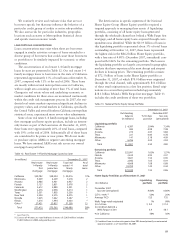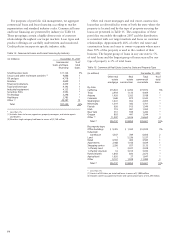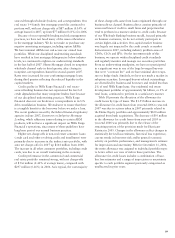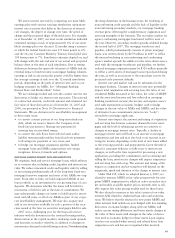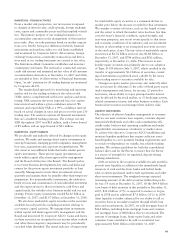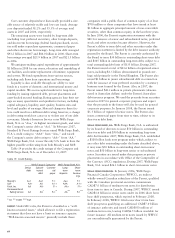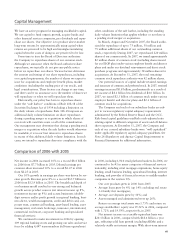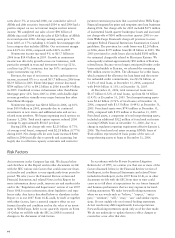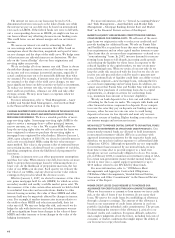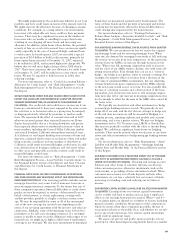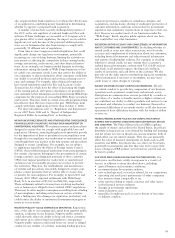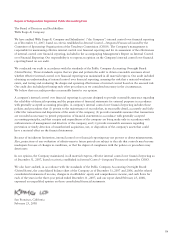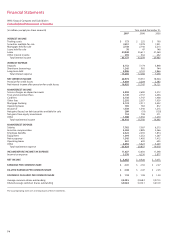Wells Fargo 2007 Annual Report Download - page 67
Download and view the complete annual report
Please find page 67 of the 2007 Wells Fargo annual report below. You can navigate through the pages in the report by either clicking on the pages listed below, or by using the keyword search tool below to find specific information within the annual report.
64
Core customer deposits have historically provided a size-
able source of relatively stable and low-cost funds. Average
core deposits funded 58.2% and 55.3% of average total
assets in 2007 and 2006, respectively.
The remaining assets were funded by long-term debt
(including trust preferred securities), other foreign deposits,
and short-term borrowings (federal funds purchased, securi-
ties sold under repurchase agreements, commercial paper
and other short-term borrowings). Long-term debt averaged
$93.2 billion in 2007 and $84.0 billion in 2006. Short-term
borrowings averaged $25.9 billion in 2007 and $21.5 billion
in 2006.
We anticipate making capital expenditures of approximately
$1 billion in 2008 for our stores, relocation and remodeling of
our facilities, and routine replacement of furniture, equipment
and servers. We fund expenditures from various sources,
including cash flows from operations and borrowings.
Liquidity is also available through our ability to raise
funds in a variety of domestic and international money and
capital markets. We access capital markets for long-term
funding by issuing registered debt, private placements and
asset-backed secured funding. Rating agencies base their rat-
ings on many quantitative and qualitative factors, including
capital adequacy, liquidity, asset quality, business mix and
level and quality of earnings. Material changes in these fac-
tors could result in a different debt rating; however, a change
in debt rating would not cause us to violate any of our debt
covenants. Moody’s Investors Service rates Wells Fargo
Bank, N.A. as “Aaa,” its highest investment grade, and rates
the Company’s senior debt as “Aa1.” In February 2007,
Standard & Poor’s Ratings Services raised Wells Fargo Bank,
N.A.’s credit rating to “AAA” from “AA+,” and raised
the Company’s senior debt rating to “AA+” from “AA.”
Wells Fargo Bank, N.A. is now the only U.S. bank to have the
highest possible credit rating from both Moody’s and S&P.
Table 19 provides the credit ratings of the Company and
Wells Fargo Bank, N.A. as of December 31, 2007.
companies with a public float of common equity of at least
$700 million or those companies that have issued at least
$1 billion in aggregate principal amount of non-convertible
securities, other than common equity, in the last three years.
In June 2006, the Parent’s registration statement with the
SEC for issuance of senior and subordinated notes, preferred
stock and other securities became effective. However, the
Parent’s ability to issue debt and other securities under this
registration statement is limited by the debt issuance authority
granted by the Board. The Parent is currently authorized by
the Board to issue $30 billion in outstanding short-term debt
and $105 billion in outstanding long-term debt, subject to a
total outstanding debt limit of $135 billion. During 2007,
the Parent issued a total of $21.6 billion of registered senior
notes, including $1.5 billion (denominated in pounds ster-
ling) sold primarily in the United Kingdom. The Parent also
issued $1 billion in junior subordinated debt in connection
with the issuance of trust preferred securities by a statutory
business trust formed by the Parent. Also, in 2007, the
Parent issued $413 million in private placements (denomi-
nated in Australian dollars) under the Parent’s Australian
debt issuance program. We used the proceeds from securities
issued in 2007 for general corporate purposes and expect
that the proceeds in the future will also be used for general
corporate purposes. In January 2008, the Parent issued
$5.5 billion of registered senior notes. The Parent also
issues commercial paper from time to time, subject to its
short-term debt limit.
WELLS FARGO BANK, N.A. Wells Fargo Bank, N.A. is authorized
by its board of directors to issue $50 billion in outstanding
short-term debt and $50 billion in outstanding long-term
debt. In December 2007, Wells Fargo Bank, N.A. established
a $100 billion bank note program under which, subject to
any other debt outstanding under the limits described above,
it may issue $50 billion in outstanding short-term senior
notes and $50 billion in long-term senior or subordinated
notes. Securities are issued under this program as private
placements in accordance with Office of the Comptroller of
the Currency (OCC) regulations. During 2007, Wells Fargo
Bank, N.A. issued $26.1 billion in short-term senior notes.
WELLS FARGO FINANCIAL. In January 2006, Wells Fargo
Financial Canada Corporation (WFFCC), an indirect
wholly-owned Canadian subsidiary of the Parent, qualified
with the Canadian provincial securities commissions
CAD$7.0 billion of medium-term notes for distribution
from time to time in Canada. During 2007, WFFCC issued
CAD$1.4 billion in senior notes under its 2006 short form
base shelf prospectus, which expired in February 2008.
In February 2008, WFFCC filed a new short form base
shelf prospectus qualifying an additional CAD$7.0 billion
of issuance authority and issued CAD$500 million of
medium-term notes, leaving CAD$6.5 billion available for
future issuance. All medium-term notes issued by WFFCC
are unconditionally guaranteed by the Parent.
Table 19: Credit Ratings
Wells Fargo & Company Wells Fargo Bank, N.A.
Senior Subord- Commer- Long- Short-
debt inated cial term term
debt paper deposits borrow-
ings
Moody’s Aa1 Aa2 P-1 Aaa P-1
S&P AA+ AA A-1+ AAA A-1+
Fitch, Inc. AA AA- F1+ AA+ F1+
Dominion Bond
Rating Service AA AA*R-1** AA*** R-1***
*low ** middle *** high
PARENT. Under SEC rules, the Parent is classified as a “well-
known seasoned issuer,” which allows it to file a registration
statement that does not have a limit on issuance capacity.
“Well-known seasoned issuers” generally include those



